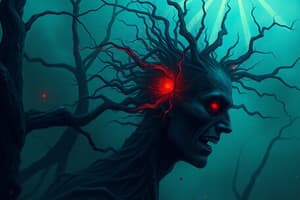Podcast
Questions and Answers
¿Cuáles de los siguientes son síntomas de primer rango según Schneider?
¿Cuáles de los siguientes son síntomas de primer rango según Schneider?
- Escuchar voces que dialogan entre sí (correct)
- Perplejidad
- Empobrecimiento afectivo
- Ocurrencias delirantes
Entre las características de las psicosis esquizofreniformes, se destaca que:
Entre las características de las psicosis esquizofreniformes, se destaca que:
- Siempre son tratados con antipsicóticos
- Suelen presentar un inicio insidioso (correct)
- Tienen un pronóstico generalmente malo
- El deterioro del paciente es progresivo
¿Cuál de las siguientes opciones NO es un síntoma negativo mencionada en el contenido?
¿Cuál de las siguientes opciones NO es un síntoma negativo mencionada en el contenido?
- Ocurrencias delirantes (correct)
- Despersonalización
- Embotamiento afectivo
- Sentimientos de desrealización
¿Cuál de los siguientes síntomas NO es característico de la esquizofrenia?
¿Cuál de los siguientes síntomas NO es característico de la esquizofrenia?
¿Cuál de las siguientes características es común en las fasofrenias o psicosis cicloides?
¿Cuál de las siguientes características es común en las fasofrenias o psicosis cicloides?
Dentro de los síntomas de segundo rango, ¿cuál de los siguientes se considera un síntoma válido?
Dentro de los síntomas de segundo rango, ¿cuál de los siguientes se considera un síntoma válido?
En relación a la cognición social, ¿cuál es una de sus características?
En relación a la cognición social, ¿cuál es una de sus características?
¿Qué forma de evolución de la esquizofrenia se caracteriza por no tener episodios psicóticos?
¿Qué forma de evolución de la esquizofrenia se caracteriza por no tener episodios psicóticos?
¿Qué se debe hacer si un paciente con psicosis esquizofreniformes no muestra evolución favorable?
¿Qué se debe hacer si un paciente con psicosis esquizofreniformes no muestra evolución favorable?
¿Cuál de los siguientes síntomas es considerado un síntoma positivo?
¿Cuál de los siguientes síntomas es considerado un síntoma positivo?
¿Cuál de las siguientes opciones describe mejor el síndrome de pasividad en esquizofrenia?
¿Cuál de las siguientes opciones describe mejor el síndrome de pasividad en esquizofrenia?
El deterioro en un paciente con esquizofrenia está normalmente asociado con:
El deterioro en un paciente con esquizofrenia está normalmente asociado con:
¿Cuál afirmación sobre los síntomas de primer rango es correcta?
¿Cuál afirmación sobre los síntomas de primer rango es correcta?
¿Cuál de las siguientes afirmaciones sobre los tratamientos antipsicóticos es cierta?
¿Cuál de las siguientes afirmaciones sobre los tratamientos antipsicóticos es cierta?
Dentro de la clasificación de la esquizofrenia, la evolución paradigmática es caracterizada por:
Dentro de la clasificación de la esquizofrenia, la evolución paradigmática es caracterizada por:
¿Qué tipo de comportamiento puede aparecer en algunos casos de esquizofrenia?
¿Qué tipo de comportamiento puede aparecer en algunos casos de esquizofrenia?
¿Qué relación existe entre los antipsicóticos atípicos y la actividad dopaminérgica a nivel mesolímbico?
¿Qué relación existe entre los antipsicóticos atípicos y la actividad dopaminérgica a nivel mesolímbico?
¿Cuál de las siguientes afirmaciones sobre los síntomas negativos es correcta?
¿Cuál de las siguientes afirmaciones sobre los síntomas negativos es correcta?
¿Cómo se clasifican los síntomas de la esquizofrenia en base a la actividad dopaminérgica?
¿Cómo se clasifican los síntomas de la esquizofrenia en base a la actividad dopaminérgica?
¿Qué efectos secundarios son menos comunes al usar antipsicóticos atípicos?
¿Qué efectos secundarios son menos comunes al usar antipsicóticos atípicos?
¿Cuál de las siguientes combinaciones de trastornos menciona otros trastornos psicóticos?
¿Cuál de las siguientes combinaciones de trastornos menciona otros trastornos psicóticos?
¿Cuál es la función de los bloqueadores serotoninérgicos en los antipsicóticos atípicos?
¿Cuál es la función de los bloqueadores serotoninérgicos en los antipsicóticos atípicos?
¿Cuál de las siguientes afirmaciones es incorrecta sobre los antipsicóticos clásicos?
¿Cuál de las siguientes afirmaciones es incorrecta sobre los antipsicóticos clásicos?
¿Cuál es un factor de riesgo importante para comorbilidades en pacientes esquizofrénicos?
¿Cuál es un factor de riesgo importante para comorbilidades en pacientes esquizofrénicos?
Flashcards
Psicosis esquizofreniformes
Psicosis esquizofreniformes
Síntomas agudos similares a la esquizofrenia, pero con buen pronóstico, remisión completa y sin deterioro.
Síntomas de primer rango
Síntomas de primer rango
Síntomas cruciales para diagnosticar esquizofrenia: incluyen percepción de pensamientos propios, voces que dialogan o comentan, vivencias de influencia corporal y robos de pensamientos.
Síntomas de segundo rango
Síntomas de segundo rango
Síntomas secundarios en la esquizofrenia. Incluyen delirios, confusión, emociones disminuidas, y sensaciones equivocadas.
Fasofrenias/Psicosis cicloides
Fasofrenias/Psicosis cicloides
Signup and view all the flashcards
Despersonalización
Despersonalización
Signup and view all the flashcards
Autismo
Autismo
Signup and view all the flashcards
Embotamiento afectivo
Embotamiento afectivo
Signup and view all the flashcards
Robo o inserción del pensamiento
Robo o inserción del pensamiento
Signup and view all the flashcards
Síndrome de pasividad
Síndrome de pasividad
Signup and view all the flashcards
Cognición social
Cognición social
Signup and view all the flashcards
¿Qué caracteriza el comportamiento en la esquizofrenia?
¿Qué caracteriza el comportamiento en la esquizofrenia?
Signup and view all the flashcards
Primer episodio de esquizofrenia
Primer episodio de esquizofrenia
Signup and view all the flashcards
Episodios múltiples de esquizofrenia
Episodios múltiples de esquizofrenia
Signup and view all the flashcards
Curso continuo de la esquizofrenia
Curso continuo de la esquizofrenia
Signup and view all the flashcards
Evolución paradigmática de la esquizofrenia
Evolución paradigmática de la esquizofrenia
Signup and view all the flashcards
Antipsicóticos atípicos
Antipsicóticos atípicos
Signup and view all the flashcards
Síntomas positivos de la esquizofrenia
Síntomas positivos de la esquizofrenia
Signup and view all the flashcards
Síntomas negativos de la esquizofrenia
Síntomas negativos de la esquizofrenia
Signup and view all the flashcards
Antipsicóticos clásicos
Antipsicóticos clásicos
Signup and view all the flashcards
Hiperactividad dopaminérgica (mesolímbica)
Hiperactividad dopaminérgica (mesolímbica)
Signup and view all the flashcards
Hipoactividad dopaminérgica (mesocortical)
Hipoactividad dopaminérgica (mesocortical)
Signup and view all the flashcards
Sistema límbico
Sistema límbico
Signup and view all the flashcards
Trastorno esquizoafectivo
Trastorno esquizoafectivo
Signup and view all the flashcards
Study Notes
General Summary of Esquizofrenia
- Esquizofrenia is a serious mental illness that affects a person's ability to think, feel, and behave clearly.
- Symptoms vary among individuals, but often include hallucinations, delusions, and disorganized thinking.
- Early signs may appear in adolescence or early adulthood, though diagnosis typically occurs later.
- The cause of schizophrenia is complex and not fully understood, but likely involves a combination of genetic and environmental factors.
Evolution of the Concept of Schizophrenia
- Morel (1860) coined the term "démence précoce" (early-onset dementia) because of the intellectual decline observed in adolescents, which differentiates it from dementia in older individuals.
- Morel noted symptoms emerging during adolescence, contrasting with the typical later onset of dementia.
Phases of Schizophrenia
- Initial Phases:
- Isolation (Autism): Individuals become socially withdrawn, aware of their deficits, and distancing themselves from others.
- Strange Mannerisms: Repetitive and purposeless gestures or behaviors.
- Neglect of Self-Care: Individuals stop maintaining basic hygiene and personal care.
- Final Phases:
- Intellectual Deterioration: Progressive cognitive decline similar to that seen in dementia, affecting the individual's mental abilities over time.
Other Key Figures and Concepts
- Kahlbaum (1863): Introduced the concept of catatonia, a condition characterized by unusual motor behaviors.
- Hecker (1871): Described hebefrenia, a severe form of schizophrenia characterized by childlike behavior and disorganized thinking.
- Kraepelin (1893): Clarified the definition of schizophrenia, separating it from other psychoses. Described two main symptoms:
- Destruction of Personality (self): Core symptom of personality deterioration.
- Impairment of Emotions and Volition: Diminished emotional responsiveness and motivation, loss of interest in the world.
- Kasanin (1933): Identified Schizoaffective Disorder. A condition with Schizophrenia symptoms and mood episodes.
- Langfeldt (1939): Emphasized the difficulty in diagnosing schizophrenia in the initial stages, requiring careful observation over time.
- Andreasen (1983): Categorized schizophrenic symptoms into positive and negative symptoms (e.g., hallucinations, delusions versus flat affect, alogia).
Classification of Schizophrenia (CIE-11)
- Schizophrenia (acute), multiple episodes, chronic phase: Emphasized the importance of early identification and treatment to improve long-term outcomes.
- Schizoaffective Disorder: A condition with schizophrenia symptoms and mood episodes.
- Schizotypal Disorder: Condition featuring odd or eccentric behaviors and discomfort in social settings.
- Brief Psychotic Disorder: Short-lived psychotic episodes lasting less than a month, with an eventual return to normal function.
- Delusional Disorder: Condition characterized by persistent delusions without other significant psychotic symptoms.
- Schizophrenia: Characterized by symptoms including hallucinations, delusions, and disorganized thinking.
Epidemiology of Schizophrenia
- Typically emerges in late adolescence or early adulthood.
- Early signs might manifest as social withdrawal, academic difficulties, unusual behaviors.
Etiology of Schizophrenia
- Genetic factors account for approximately 80% of the risk.
- Alterations related to cellular and immunologic functions.
- Possible environmental influences (e.g., complications during pregnancy or early life experiences).
- Neurotransmitter imbalance (dopamine, serotonin, and GABA) can also affect.
Clinical Presentations of Schizophrenia
- Positive Symptoms: Delusions (false beliefs), hallucinations (seeing or hearing things that aren't there), disorganized thinking or speech.
- Negative Symptoms: Flat affect (reduced emotional expression), alogia (reduced speech), avolition (lack of motivation), anhedonia (inability to experience pleasure).
- Cognitive Symptoms: Decreased attention, memory problems, difficulty making decisions, or maintaining tasks.
- Disorganization: Incoherent speech, inappropriate behavior, disorganized thoughts or speech.
Management of Comorbidity in Schizophrenia
- Mood disorders: Depression is the most frequent comorbidity; patients may also experience manic episodes or hypomania.
- Anxiety disorders: Anxiety often accompanies schizophrenia and can significantly impact quality of life.
- Substance use disorders: Patients with schizophrenia are more likely to abuse drugs and alcohol, increasing complications.
- Other disorders: Other medical and/or psychiatric conditions can occur concurrently with schizophrenia.
Treatment Approaches
- Biological Treatments: Antipsychotics (typical and atypical) are the core medication.
- Psychosocial Interventions: Therapy and psychosocial support can enhance patient functioning, address social skills, and improve adherence to medication requirements.
Additional Considerations
- Importance of Early Diagnosis and Treatment: Early intervention and consistent treatment can significantly improve outcomes for individuals with schizophrenia, minimizing long-term cognitive decline.
- Ongoing Management and Support: Long-term care is necessary to manage symptoms and minimize relapses.
Studying That Suits You
Use AI to generate personalized quizzes and flashcards to suit your learning preferences.



